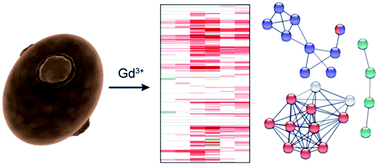Delineating toxicity mechanisms associated with MRI contrast enhancement through a multidimensional toxicogenomic profiling of gadolinium†
Abstract
Gadolinium is a metal used in contrast agents for magnetic resonance imaging. Although gadolinium is widely used in clinical settings, many concerns regarding its toxicity and bioaccumulation after gadolinium-based contrast agent administration have been raised and published over the last decade. To date, most toxicological studies have focused on identifying acute effects following gadolinium exposure, rather than investigating associated toxicity mechanisms. In this study, we employ functional toxicogenomics to assess mechanistic interactions of gadolinium with Saccharomyces cerevisiae. Furthermore, we determine which mechanisms are conserved in humans, and their implications for diseases related to the use of gadolinium-based contrast agents in medicine. A homozygous deletion pool of 4291 strains were screened to identify biological functions and pathways disturbed by the metal. Gene ontology and pathway enrichment analyses showed endocytosis and vesicle-mediated transport as the main yeast response to gadolinium, while certain metabolic processes, such as glycosylation, were the primary disrupted functions after the metal treatments. Cluster and protein–protein interaction network analyses identified proteins mediating vesicle-mediated transport through the Golgi apparatus and the vacuole, and vesicle cargo exocytosis as key components to reduce the metal toxicity. Moreover, the metal seemed to induce cytotoxicity by disrupting the function of enzymes (e.g. transferases and proteases) and chaperones involved in metabolic processes. Several of the genes and proteins associated with gadolinium toxicity are conserved in humans, suggesting that they may participate in pathologies linked to gadolinium-based contrast agent exposures. We thereby discuss the potential role of these conserved genes and gene products in gadolinium-induced nephrogenic systemic fibrosis, and propose potential prophylactic strategies to prevent its adverse health effects.



 Please wait while we load your content...
Please wait while we load your content...
